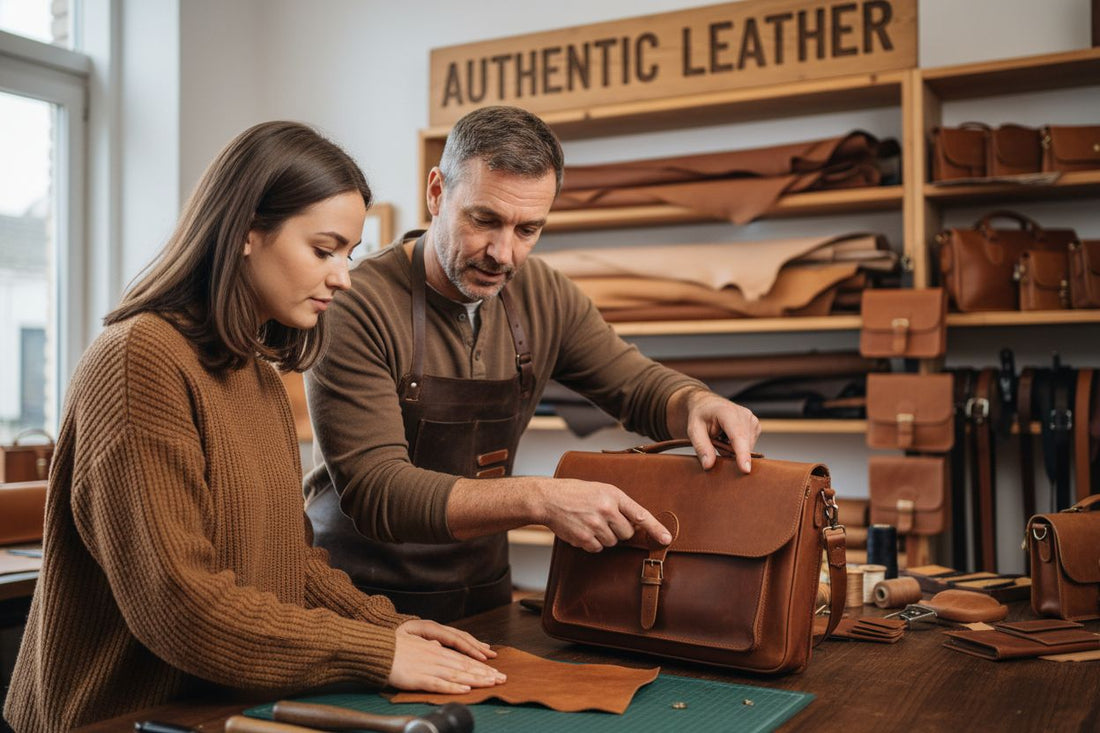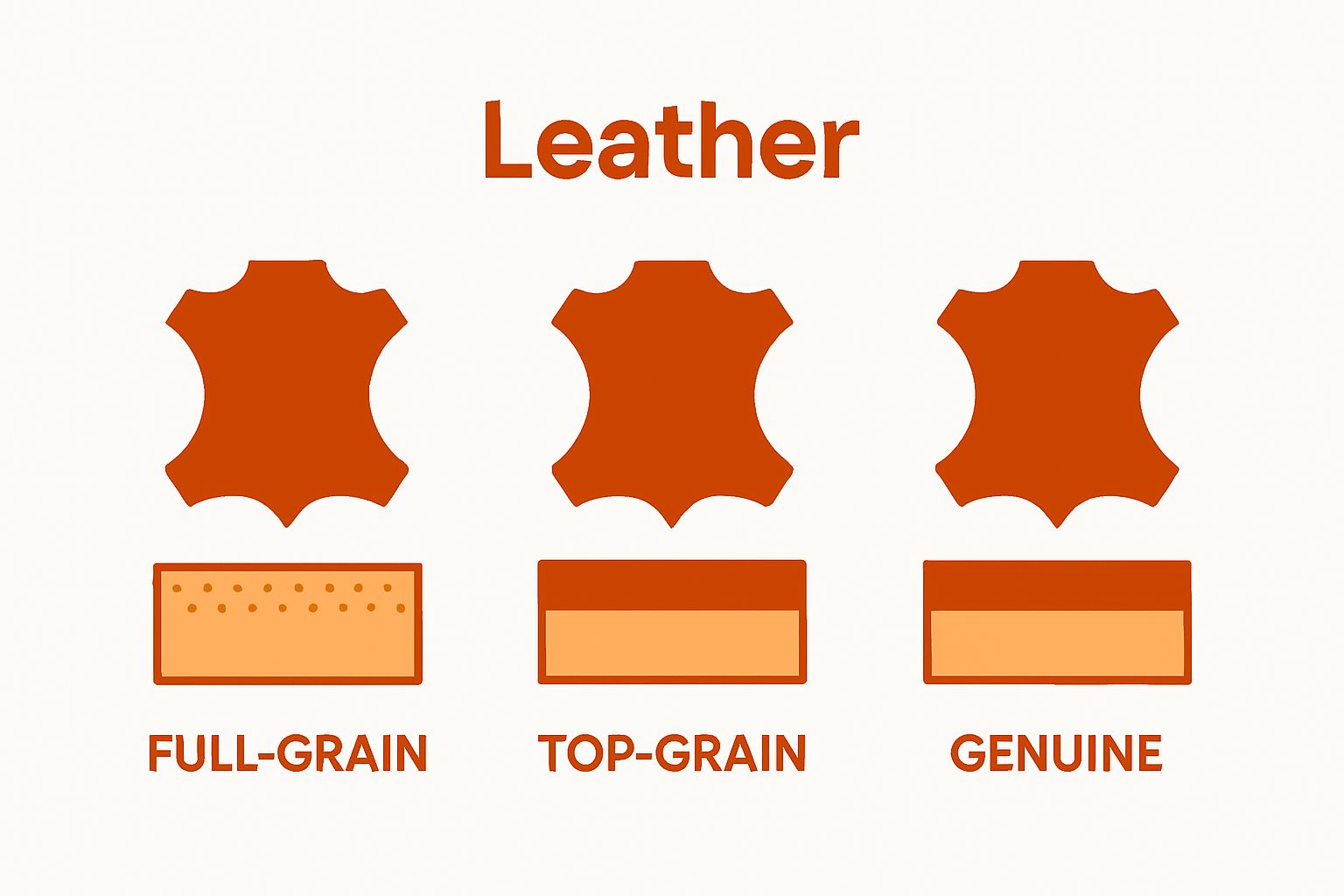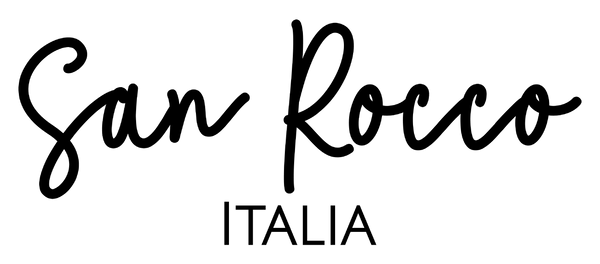
Understanding How to Identify Authentic Leather
Share
Leather bags and shoes flood the shops, promising luxury and long life. Yet only a small fraction of these truly stand the test of time. Some may look flawless, but perfect uniformity often signals artificial manufacturing, not genuine leather. The real treasures reveal their authenticity with subtle imperfections and a patina that grows richer every year.
Table of Contents
- What Constitutes Authentic Leather?
- The Importance Of Authenticity In Leather Goods
- Key Characteristics To Recognise Quality Leather
- Distinguishing Genuine Leather From Alternatives
- The Role Of Craftsmanship In Authentic Leather
Quick Summary
| Takeaway | Explanation |
|---|---|
| Authentic leather originates from animal hides. | Genuine leather is made from natural materials, retaining original grain and structure through careful tanning. |
| Quality leather develops a unique patina over time. | Authentic leather ages gracefully, developing character and beauty that synthetic materials lack. |
| Recognise leather by tactile and visual characteristics. | Look for natural grain variations, soft texture, and distinct leather scent to identify genuine products. |
| Proper crafting techniques enhance leather quality. | Skilled artisans use traditional methods to preserve leather’s intrinsic qualities, ensuring durability and aesthetic appeal. |
| Choose authentic leather for long-term value. | Genuine leather offers superior durability, breathability, and performance compared to synthetic alternatives, representing an investment. |
What Constitutes Authentic Leather?
Authentic leather represents a complex material with specific characteristics that distinguish it from synthetic imitations. The true essence of leather lies in its natural origin, structural integrity, and unique manufacturing process that transforms raw animal hide into a durable, flexible material.
The Natural Origins of Quality Leather
Authentic leather begins its journey as an animal hide, most commonly sourced from cattle, but also from goats, sheep, and occasionally more exotic animals. Research from the Leather Industries of America indicates that genuine leather must maintain the original fibrous structure of the hide after processing. This means the material retains its natural grain, texture, and inherent strength characteristics that synthetic materials cannot replicate.
The hallmark of authentic leather involves preserving the hide’s original cellular structure through a meticulous tanning process. This transformation involves several critical steps:
- Removing hair and flesh from the raw hide
- Treating the material with chemical solutions to stabilise its structure
- Conditioning to maintain flexibility and durability
- Finishing processes that enhance appearance and performance
Identifying Authentic Leather Characteristics
Discerning authentic leather requires understanding its fundamental properties. Genuine leather possesses unique tactile and visual qualities that set it apart from synthetic alternatives. True leather will:
- Demonstrate natural variations in grain and texture
- Develop a patina over time, gaining character with age
- Possess a distinct, subtle leather scent
- Show slight imperfections that indicate its organic origin
Professional leather experts use multiple techniques to verify authenticity, including microscopic examination of the hide’s cellular structure and assessment of its physical properties.
To help distinguish between different types of leather and their unique attributes, the following table compares full-grain, top-grain, and genuine leather as referenced in the article.
| Leather Type | Description | Key Qualities |
|---|---|---|
| Full-grain | Highest grade, retains original grain and natural surface | Most durable; develops rich patina; shows imperfections |
| Top-grain | Grain layer lightly sanded and finished | Smoother surface; durable but slightly less than full-grain |
| Genuine leather | Processed from lower layers of hide | Less durable; more uniform appearance; affordable |
| These methods help distinguish between full-grain, top-grain, and genuine leather classifications, each representing different levels of processing and quality. |

Understanding leather’s authentic nature goes beyond mere visual inspection. It requires appreciation of the material’s complex manufacturing process, its natural origins, and the craftsmanship involved in transforming a raw hide into a sophisticated, long-lasting material.
The Importance of Authenticity in Leather Goods
Authenticity in leather goods transcends mere material selection. It represents a profound commitment to quality, sustainability, and craftsmanship that significantly impacts both consumer experience and environmental responsibility.
Quality and Performance Implications
Authentic leather delivers superior performance characteristics that synthetic alternatives cannot match. Research on biopolymer materials demonstrates that genuine leather possesses unique natural properties enabling exceptional durability, breathability, and adaptability. These intrinsic qualities mean authentic leather products outlast synthetic counterparts, providing remarkable long-term value.
Key performance advantages of authentic leather include:
- Natural resistance to wear and tear
- Enhanced ability to regulate temperature
- Superior moisture management
- Increased tensile strength
- Capacity to develop aesthetic patina over time
Ethical and Environmental Considerations
Choosing authentic leather involves understanding its broader ecological and ethical implications. Responsible leather production prioritises sustainable sourcing, minimising environmental impact and supporting traditional craftsmanship. Read more about our commitment to Italian leather craftsmanship.
Authentic leather represents a circular economy product, where materials are sourced responsibly, processed with minimal waste, and designed to last significantly longer than mass-produced synthetic alternatives. This approach reduces overall environmental consumption and supports traditional manufacturing techniques.
Consumers seeking genuine leather products contribute to preserving artisanal skills, supporting local economies, and investing in materials with inherent longevity. The decision to choose authentic leather goes beyond aesthetic preferences, reflecting a commitment to quality, sustainability, and respect for traditional manufacturing processes.
Key Characteristics to Recognise Quality Leather
Recognising high-quality leather requires a sophisticated understanding of its intrinsic characteristics, beyond surface-level appearances. Professional leather experts evaluate multiple nuanced factors to distinguish superior materials from inferior alternatives.
Visual and Tactile Assessment
Authentic quality leather exhibits distinctive sensory characteristics that synthetic materials cannot replicate. Research from Materials Science Journals indicates that genuine leather presents unique textural and visual properties that reveal its true nature.
Key visual and tactile indicators include:
- Natural grain variations with subtle imperfections
- Soft, supple texture that feels warm to touch
- Slight variations in colour and surface texture
- Ability to flex and move without cracking
- Rich, deep colouration that appears organic
Professional leather specialists understand that perfect uniformity often signals artificial manufacturing. Natural leather’s beauty emerges through its inherent irregularities and nuanced character.
Structural Integrity and Durability Markers
Beyond aesthetic qualities, superior leather demonstrates remarkable structural resilience. Learn more about the benefits of Italian leather quality and understand how craftsmanship determines material excellence.
Durability markers include:
- Resistance to stretching and deformation
- Capacity to maintain shape over extended periods
- Strong, tight fibrous structure
- Minimal surface cracking under stress
- Gradual, elegant ageing process
True quality leather transforms with use, developing a rich patina that enhances its aesthetic appeal while maintaining structural integrity. This characteristic distinguishes premium leather from mass-produced synthetic alternatives, representing a testament to natural material’s remarkable properties.

Distinguishing Genuine Leather from Alternatives
Navigating the complex landscape of leather materials requires sophisticated understanding of the fundamental differences between authentic leather and synthetic imitations. Discerning consumers must develop keen observational skills to identify genuine leather products.
Scientific and Sensory Detection Methods
Authentic leather presents distinctive characteristics that mass-produced synthetic alternatives cannot replicate. Research from Materials Engineering Journals highlights the molecular complexity that distinguishes genuine leather from artificial materials.
Professional identification techniques include:
- Microscopic fibre structure examination
- Temperature and flexibility stress testing
- Detailed surface texture analysis
- Chemical composition verification
- Thermal conductivity measurements
Practical Consumer Verification Techniques
Consumers can employ several practical methods to assess leather authenticity. Explore our comprehensive guide on leather types to understand the nuanced differences between materials.
Quick authentication strategies involve:
- Performing a moisture absorption test
- Examining edges for layered construction
- Checking for natural grain inconsistencies
- Smelling for distinctive leather aroma
- Observing how material responds to gentle bending
Genuine leather tells a story through its imperfections, revealing a complex manufacturing process that synthetic materials cannot emulate. Understanding these subtle distinctions empowers consumers to make informed purchasing decisions, recognising true craftsmanship and material quality beyond superficial appearances.
For greater clarity, the table below organises the practical techniques consumers can use to verify authentic leather as mentioned in the article.
| Verification Technique | What to Look For |
|---|---|
| Moisture absorption test | Genuine leather absorbs moisture effectively |
| Edge examination | Look for layered or fibrous construction |
| Grain inconsistency inspection | Natural grain variations and imperfections |
| Scent test | Distinct, subtle authentic leather aroma |
| Flexibility and bending test | Material flexes without cracking |
The Role of Craftsmanship in Authentic Leather
Craftsmanship represents the quintessential element that transforms raw leather into extraordinary products, elevating simple materials into sophisticated, enduring works of art. Beyond mechanical production, true craftsmanship embodies generations of inherited skill, precision, and deep understanding of leather’s inherent characteristics.
Traditional Techniques and Skill Preservation
Authentic leather craftsmanship transcends mere manufacturing, representing a delicate dialogue between artisan and material. Research on artisanal production techniques demonstrates how traditional skills preserve leather’s intrinsic qualities.
Critical traditional crafting techniques include:
- Hand selection of premium hide
- Meticulous cutting to preserve natural grain
- Precise manual stitching techniques
- Careful vegetable tanning processes
- Detailed edge finishing and burnishing
Artisanal Skills and Material Transformation
Skilled artisans understand leather as a living material, capable of evolving and developing character. Learn more about Italian leather craftsmanship and discover the nuanced art behind exceptional leather goods.
Key artisanal transformation processes involve:
- Understanding hide variations
- Reading leather’s natural characteristics
- Applying techniques that enhance material properties
- Creating products that age gracefully
- Minimising waste through precision cutting
Genuine craftsmanship turns leather into a narrative, where each stitch and fold tells a story of skill, tradition, and respect for material. The artisan’s touch transforms leather from a mere substrate into an expression of cultural heritage and individual creativity.
Discover Genuine Italian Leather with Confidence
Are you tired of questioning whether your leather goods are truly authentic? The article has shown how difficult it can be to separate genuine leather from mass-produced imitations. You have learned about features like natural grain, subtle imperfections, and the skilled craftsmanship that signify premium materials, but spotting real quality can remain a challenge, especially when shopping online. Many readers are looking for leather they can trust, made with respect for both tradition and the environment.

You deserve to experience authentic leather that stands the test of time. At San Rocco Italia, every handbag and accessory is made in Italy by experienced artisans using only premium full-grain leather and traditional techniques. For a closer look at our dedication to true craftsmanship, read our in-depth article on Italian leather craftsmanship or explore the benefits of Italian leather. Visit San Rocco Italia today to find genuinely authentic leather pieces, and bring home the integrity, artistry, and style you have read about. Act now to invest in quality you can instantly recognise and feel.
Frequently Asked Questions
How can I tell if a leather product is authentic?
To identify authentic leather, look for natural variations in grain and texture, as well as slight imperfections that indicate its organic origin. Inspect the product closely for a distinct leather scent and soft, supple texture, which are signs of genuine material.
What are the key characteristics of authentic leather?
Authentic leather features natural grain variations, a unique patina that develops over time, and a warm feel to the touch. To assess, consider performing a moisture absorption test; genuine leather will absorb moisture more effectively than synthetic alternatives.
What steps are involved in the tanning process that makes leather authentic?
The tanning process involves several key steps, including removing hair and flesh, treating the hide with chemicals for stability, and conditioning it for flexibility. Familiarise yourself with these steps to better understand how they contribute to the quality and durability of the leather.
How can I verify the authenticity of leather using physical tests?
You can verify leather authenticity through practical tests such as checking for moisture absorption and examining edges for layered construction. Conduct these tests before making a purchase to ensure you invest in genuine leather products.
Why is it important to choose authentic leather over synthetic options?
Choosing authentic leather is vital for its superior durability, breathability, and long-term value compared to synthetic alternatives. By selecting genuine leather, you support craftsmanship and sustainable practices that prioritise quality and environmental responsibility.
How does craftsmanship affect the quality of authentic leather?
Craftsmanship plays a crucial role in determining the quality of authentic leather. Investigate the artisanal techniques used in making the product, such as hand selection of hide and meticulous stitching, to appreciate the skill and care behind each piece.
Recommended
- Understanding the Benefits of Italian Leather Quality – San Rocco Italia
- Understanding How Italian Leather is Made: A Comprehensive Guide – San Rocco Italia
- 8 Best Italian Leather Handbags Made in Italy to Explore – San Rocco Italia
- Understanding Vegetable Tanned Leather Patina: Beauty Unveiled – San Rocco Italia


